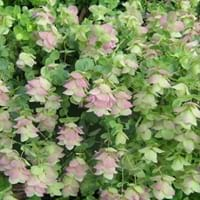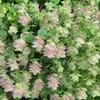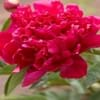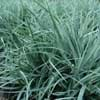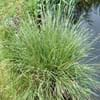Life Span
Perennial
Perennial
Origin
Hybrid origin
Mid-Atlantic United States, Southeastern United States, South-Central United States, Texas
Types
Kent Beauty
Amethyst Falls
Barbara Tingey
Not Available
Number of Varieties
Not Available
Habitat
Grassland, Open scrub, Rocky areas
Dappled Shade, Shady Edge, Woodland Garden Secondary
USDA Hardiness Zone
5-8
4-9
Sunset Zone
Not Available
3a, 3b, 4, 5, 6, 7, 8, 9, 14, 15, 16, 17, 18, 19, 20, 21, 22, 23, 24
Habit
Clump-Forming
Thicket/Colonizing
Minimum Height
Not Available
Minimum Width
Not Available
Flower Color
Pink
White, Green, Ivory
Flower Color Modifier
Bicolor
Bicolor
Fruit Color
Not Available
Purple, Black
Leaf Color in Spring
Dark Green
Green, Blue Green, Dark Green
Leaf Color in Summer
Dark Green
Green, Blue Green, Dark Green
Leaf Color in Fall
Dark Green
Yellow, Green, Purple, Blue Green, Dark Green, Yellow green
Leaf Color in Winter
Light Green
Not Available
Leaf Shape
Oval
bipinnate
Plant Season
Summer, Fall
Spring, Summer, Fall, Winter
Sunlight
Full Sun
Full Sun, Partial Sun
Type of Soil
Loam
Clay, Loam, Sand
The pH of Soil
Neutral, Alkaline
Acidic, Neutral, Alkaline
Soil Drainage
Well drained
Well drained
Bloom Time
Late Summer, Early Fall
Summer
Tolerances
Drought
Pollution, Soil Compaction
Where to Plant?
Container, Ground, Pot
Ground
How to Plant?
Seedlings
Cuttings, Divison, Seedlings
Plant Maintenance
Medium
Medium
Watering Requirements
Allow soil to be completely dry in between waterings, Does not require lot of watering, Water twice a day in the initial period, Water when soil is dry
Needs high amount of water
In Summer
Lots of watering
Lots of watering
In Spring
Moderate
Moderate
In Winter
Average Water
Average Water
Soil pH
Neutral, Alkaline
Acidic, Neutral, Alkaline
Soil Type
Loam
Clay, Loam, Sand
Soil Drainage Capacity
Well drained
Well drained
Sun Exposure
Full Sun
Full Sun, Partial Sun
Pruning
Remove damaged leaves, Remove dead branches, Remove dead leaves
Remove damaged leaves, Remove dead branches, Remove dead leaves
Fertilizers
All-Purpose Liquid Fertilizer
All-Purpose Liquid Fertilizer
Pests and Diseases
Red blotch
Aphids, Leaf spot, Mealybugs
Plant Tolerance
Drought
Drought
Flower Petal Number
Single
Single
Fragrant Leaf
Not Available
No
Foliage Texture
Fine
Coarse
Foliage Sheen
Matte
Matte
Attracts
Butterflies
Bees, Butterflies, Insects, Not Available
Allergy
Not Available
Skin irritation
Aesthetic Uses
Showy Purposes
Borders, Woodland margins
Beauty Benefits
Not Available
Not Available
Environmental Uses
Air purification
Air purification
Medicinal Uses
Bloating, Bronchitis, Cough, Cramps, Croup, Gastrointestinal disorders, Headache, Rheumatoid arthritis, Urinary tract problems
Alterative, Analgesic, Diaphoretic, Opthalmic
Part of Plant Used
Leaves
Bark, Leaves, Root
Other Uses
Employed in herbal medicine, Used As Food
Used as a potherb
Used As Indoor Plant
Yes
No
Used As Outdoor Plant
Yes
Yes
Garden Design
Container, Edging, Groundcover, Mixed Border
Feature Plant, Foundation, Mixed Border
Botanical Name
ORIGANUM 'Rose Dome'
ARALIA spinosa
Common Name
Ornamental Oregano
American Angelica Tree, Devil's Walking Stick, Hercules' Club
In Hindi
सजावटी अजवायन
Devil's Walking Stick
In German
Ornamental Oregano
Teufelsspazierstock
In French
ornement origan
Walking bâton du diable
In Spanish
Ornamentales orégano
Bastón del Diablo
In Greek
καλλωπιστικά Ρίγανη
Περπάτημα Stick διαβόλου
In Portuguese
ornamental Oregano
Vara andando de diabo
In Polish
ozdobne Oregano
Diabelski laska
In Latin
decentius Oregano
Virgam diaboli
Phylum
Not Available
Magnoliophyta
Class
Magnoliopsida
Magnoliopsida
Order
Not Available
Apiales
Family
Lamiaceae
Araliaceae
Clade
Angiosperms, Eudicots
Angiosperms, Asterids, Eudicots
Tribe
Mentheae
Not Available
Subfamily
Pitcairnioideae
Aralioideae
Number of Species
Not Available
Not Available
Importance of Ornamental Oregano and Devil's Walking Stick
Want to have the most appropriate plant for your garden? You might want to know the importance of Ornamental Oregano and Devil's Walking Stick. Basically, these two plants vary in many aspects. Compare Ornamental Oregano and Devil's Walking Stick as they differ in many characteristics such as their life, care, benefits, facts, etc. Every gardener must at least have the slightest clue about the plants he wants to plant in his garden. Compare their benefits, which differ in many ways like facts and uses. The medicinal use of Ornamental Oregano is Bloating, Bronchitis, Cough, Cramps, Croup, Gastrointestinal disorders, Headache, Rheumatoid arthritis and Urinary tract problems whereas of Devil's Walking Stick is Alterative, Analgesic, Diaphoretic and Opthalmic. Ornamental Oregano has beauty benefits as follows: Not Available while Devil's Walking Stick has beauty benefits as follows: Not Available.
Compare Facts of Ornamental Oregano vs Devil's Walking Stick
How to choose the best garden plant for your garden depending upon its facts? Here garden plant comparison will help you to solve this query. Compare the facts of Ornamental Oregano vs Devil's Walking Stick and know which one to choose. As garden plants have benefits and other uses, allergy is also a major drawback of plants for some people. Allergic reactions of Ornamental Oregano are Not Available whereas of Devil's Walking Stick have Skin irritation respectively. Having a fruit bearing plant in your garden can be a plus point of your garden. Ornamental Oregano has no showy fruits and Devil's Walking Stick has showy fruits. Also Ornamental Oregano is flowering and Devil's Walking Stick is not flowering . You can compare Ornamental Oregano and Devil's Walking Stick facts and facts of other plants too.
